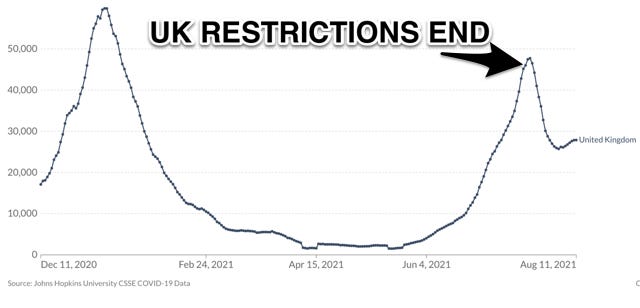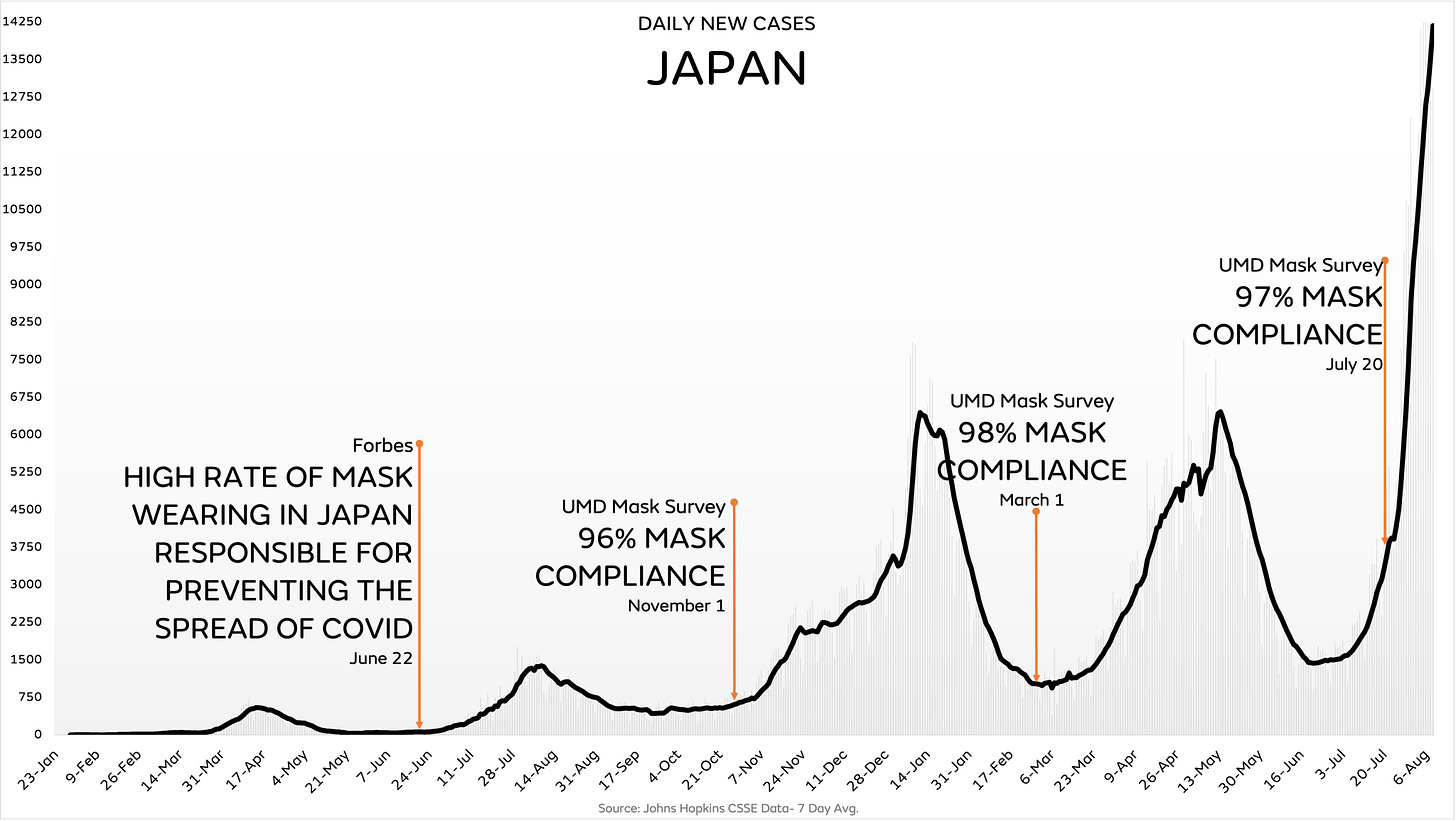Lockdowns, Masks and the Illusion of Government Control over COVID
Coercive policies have proven not only futile, but perilous

All Global Research articles can be read in 51 languages by activating the “Translate Website” drop down menu on the top banner of our home page (Desktop version).
Visit and follow us on Instagram at @crg_globalresearch.
***
In the early 11th century, King Canute—while at the peak of his power—set out to demonstrate to his fawning courtiers the limited power of royal edicts.
After having his throne placed by the sea’s edge, he sat down and commanded the tide to stop rising. When the water began washing over his feet, he declared, “Let all men know how empty and worthless is the power of kings.”
Nearly a thousand years later, facing a different force of nature—Covid-19—an entire global generation of presidents, prime ministers, governors, mayors, public health officials, scientists and citizens is being given the same lesson.
However, where Canute’s lesson sprang from his humility, this lesson springs from the hubris of the present-day ruling class and the credulity of the masses who place far too much faith in their rulers’ power.
The lesson was pointedly driven home on July 19th. That was “Freedom Day” in the United Kingdom, with government ending restrictions on social contact, allowing the reopening of remaining establishments such as nightclubs, and abandoning mask mandates.
Two weeks before Freedom Day, as the Delta variant relentlessly pushed the UK’s case count higher, 122 prominent scientists and doctors submitted a letter to The Lancet calling the planned easing of restrictions “a dangerous and unethical experiment.”
On the eve of Freedom Day, the UK’s daily case count was over 40,000 [invalid estimates]. Imperial College London mathematical biologist Neil Ferguson told the BBC it was “almost inevitable” the end of restrictions would prompt daily cases to soar to 100,000 and perhaps even 200,000.
Mother Nature was about to deliver a harsh comeuppance to Ferguson and others who’d have us believe government restrictions and mask mandates offer a potent defense against Covid contagion: Cases promptly went into a two-week free fall.
Those models, which played a key role in enabling unprecedented, draconian lockdowns around the world—have been wildly wrong again and again. For example, Imperial College London projected Sweden’s relaxed approach to Covid-19 would leave nearly 100,000 Swedes dead by July 1, 2020. The actual count: 5,700.
The United States has endured its own false alarms about what will happen when government-imposed restrictions are eased. Grim predictions and accusations of gubernatorial indifference to human life accompanied the ending of restrictions and mandates in states like Iowa, Texas and Florida, and proved as wrong as the ones made in the UK last month.
Lacking Canute’s humility and undaunted by contrary evidence, the great majority of officials, scientists and pundits who’ve favored coercive government measures have proven stubbornly incapable of entertaining the possibility that these interventions—which have boosted depression, suicide, alcohol abuse, drug overdoses, domestic violence and undiagnosed cancer—aren’t a net positive for public health after all.
That resistance to contrary evidence extends to a great many everyday citizens whose unwavering support of lockdowns, business restrictions, remote schooling and mask mandates is part of a politicized tribal identity.
Exasperatingly, that tribe embraces “trust science” as a mantra, oblivious to the fact that the scientific method hinges on the reliable replication of results that supports one’s theory—something sorely lacking where lockdowns, masking and other measures are concerned.
The “trust science” crowd is likewise oblivious to the fact that scientists are far from unanimous in supporting those government-imposed nonpharmaceutical interventions (NPIs), and that highly-credentialed scientists from esteemed institutions are among the most vigorous dissenters.
The most prominent demonstration of such dissent came with the October 2020 “Great Barrington Declaration.” Led by professors from Harvard, Oxford and Stanford, epidemiologists and public health scientists from around the world expressed their “grave concerns about the damaging physical and mental health impacts of the prevailing COVID-19 policies.”
The declaration has now been signed by more than 58,000 medical and public health scientists and medical practitioners. Their numbers and credentials don’t guarantee their views are correct; however, they do bely the presumption of a scientific consensus behind coercive mitigation policies.
Among three original Stanford signatories to the declaration is biophysics professor and Nobel Prize recipient Michael Levitt. He and a group of Stanford and international scholars have been analyzing Covid-19 data since January 2020.
Referring to the steep drop in cases after UK restrictions were eased, Levitt recently asked the Twitter-verse: “Can anyone show clear correlation between NPI or other restrictions & reduced COVID-19 cases anywhere? I keep trying & failing. We really need to know this to deal better with future pandemics.”
Levitt isn’t the only reputable scientist who sees little if any correlation between government-imposed NPIs and Covid-19 trajectories.
“We’ve ascribed far too much human authority over the virus,” said Michael Osterholm, director of the Center for Infectious Disease Research and Policy at the University of Minnesota, in a recent interview with the New York Times. “These surges have little to do with what humans do. Only recently, with vaccines, have we begun to have a real impact.”
“We had record high cases, hospitalizations and deaths in January, followed by a precipitous decline throughout February and into March…this does not reflect anything to do with…human mitigation. This is the natural ebb and flow of the virus we’ve seen time and again around the world,” said Osterholm on his Covid-19 podcast.
In that vein, those who exclusively attribute today’s surging case counts in southern states to lagging vaccination rates and purported local mismanagement should note that:
- The southern wave’s timing roughly parallels the region’s 2020 summer surge, which should prompt consideration that seasonality—alongside Delta’s greater transmissibility among even the vaccinated—may be the dominant driver
- While Florida is considered the new epicenter of the pandemic, the state’s vaccination rate matches the national average
- Oregon, despite an above-average vaccination rate, is experiencing its own sharp spike—but has been spared the kind of contemptuous scorn that journalists and Democratic politicians heap on Republican-led Florida
Every NPI Deserves Scrutiny
Over the course of the pandemic, some anti-Covid-19 measures have fallen out of favor in light of new findings and observations. For example, with the understanding that surface transmission of Covid-19 is extremely unlikely, far fewer people are wiping groceries with Clorox.
Perhaps because they’re bolted into place, the nation’s thicket of plexiglass dividers have shown more staying power, despite research indicating they may not only be futile, but could actually be making matters worse by thwarting ventilation. In March, the CDC withdrew its recommendation for barriers on school desks, but has apparently stopped short of discouraging their broad use elsewhere.
Though it’s now socially acceptable to question the use of disinfectants and plexiglass, questioning masks can get you suspended from social media and tarred as a promoter of disinformation—even when you’re citing peer-reviewed studies.
However, with other widely-embraced mitigation measures fading in light of new data, intellectually honest people should be equally open to the question of whether widespread face-covering—particularly with anything other than an N-95 mask—is worthwhile.
That forbidden discussion is starting to creep into mainstream media. In a recent appearance on CNN, the University of Minnesota’s Osterholm—a former Covid-19 advisor to President Biden—caused a stir by saying, “We know today that many of the face cloth coverings that people wear are not very effective in reducing any of the virus movement in or out.”
That’s because Covid-19 particles are astoundingly small. Hard as it is to imagine, the imperceptible gaps in surgical masks can be 1,000 times the size of a viral particle. Gaps in cloth masks are well larger than that.
Osterholman has offered a highly relatable standard by which to judge if a particular face covering serves as a meaningful barrier against particles that small: “If you were in a room with somebody smoking, would you smell it in your device that you are using?”
That standard not only eliminates cloth masks, but surgical ones too.
Beyond the realities of nanoparticle science and the conclusions of previous studies, the case for masking is undermined by what we’ve observed during the pandemic.
Sweden, for example, never widely embraced masking. While its per capita Covid death count is well higher than neighboring Finland and Norway, it’s the 15th lowest out of the 31 European Union countries and the UK.
If face-covering were such an essential life-saving practice, Sweden wouldn’t be found in the middle of the EU pack. It would be dead last.
That said, using Covid-19 death counts alone to evaluate outcomes is problematic. Different testing protocols can mean an individual would be positive in one country and negative in another. Jurisdictions also differ in what exactly comprises a Covid-19 death—was it a death from Covid or merely with Covid?
More importantly, though, when we solely focus on Covid-19 deaths, we ignore the suicides, fatal overdoses and other unintended deaths that result from the lockdowns themselves.
That’s why it’s best to compare countries using excess all-cause mortality: total deaths beyond what’s expected in a normal year. By that measure, lockdown- and mask-eschewing Sweden had one of the best 2020 excess mortality rates in all of Europe—23rd-lowest out of 30 countries.
(It again trailed Finland and Norway, but a variety of factors undermine the idea they present a full-on apples-to-apples comparison; what’s more, by some measures, Finland and Norway had even less stringent policies during the first several months of the pandemic.)
CDC is “Following the TV Pundits”
Vinay Prasad is an associate professor of medicine at the University of California San Francisco and co-author of Ending Medical Reversal: Improving Outcomes, Saving Lives. “Medical reversal” is what happens when new data shows a commonly-accepted practice is not helpful—or is actually harmful.
Decrying the lack of randomized trials backing many Covid-19 policies, Prasad recently wrote, “When it comes to non-pharmacologic interventions such as mandatory business closures, mask mandates, and countless other interventions, the shocking conclusion of the last 18 months is this: We have learned next to nothing,”
Referring to the CDC’s decision to once again recommend universal indoor masking in areas of higher Covid-19 transmission, Prasad wrote, “The CDC director calls this ‘following the science,’ but it is not. It is following the TV pundits.”
While declaring his openness to the possibility that masking can be an effective public health intervention, Prasad says mandates should be driven by evidence—and that the CDC isn’t offering any.
Prasad, who doesn’t shy away from endorsing coercive government action when he thinks it’s warranted, concludes:
“When the history books are written about the use of non-pharmacologic measures during this pandemic, we will look as pre-historic and barbaric and tribal as our ancestors during the plagues of the middle ages. What the books won’t capture is how, in the moment, our experts were simply so sure of themselves.”
*
Note to readers: Please click the share buttons above or below. Follow us on Instagram, @crg_globalresearch. Forward this article to your email lists. Crosspost on your blog site, internet forums. etc.
Featured image is from howstuffworks



